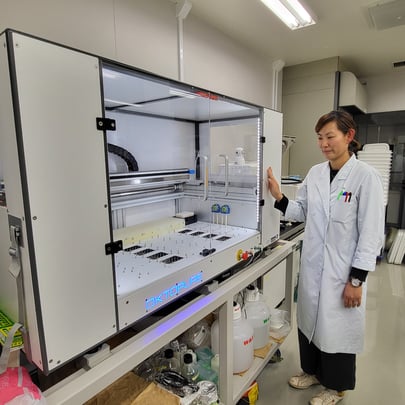Originally published : Thu, February 23, 2023 @ 3:19 PM
Updated : Tue, May 9, 2023 @ 10:48 AM
Around 159,200 tonnes of strawberries are produced annually in Japan across 5,020 ha in various regions around the country from the Miyagi-ken prefecture in the north to Nagasaki-ken in the south.1 The prefecture with the greatest strawberry output is Tochigi-ken in the north producing over 22,000 t per annum. Since 2006 total tonnage has reduced by 16.5% as less land is being used for strawberry cultivation, however total yield per ten acres has increased by 12.8% over the same period.
| The earliest cultivars of allo-octoploid (2n=8x=56) garden strawberry appeared around 300 years ago.2 The cultivated strawberry plant (Fragarie x ananassa) was introduced into Nagasaki Japan in the early 19th century, with commercial fruit production beginning around 1900 in the Kanto region around Tokyo. In 1899 Dr Hayato Fukuba selected the first Japanese cultivar, Fukuba, from the progenies of General Chanzy; Fukuba is an early June fruit bearer and was the main cultivar for 70 years in the forcing-winter production that was developed in Kuno-san in 1904.3 There are now over 70 elite variety cultivars being grown in Japan.1 The repeated crossings of elite varieties have created a germplasm where the genetic similarities between varieties have increased making it harder to produce innovative superior qualities.
|
|
Webinar on demand Using genomic prediction models for crossbreeding strawberry plants In this webinar, learn how large-scale genotyping can deliver a data driven breeding programme to significantly enhance breeders' ability to produce superior innovative varieties of strawberries. Understand how the prediction model was created, and discover the benefits of using KASP for the selection of young seedlings for planting.
Dr Sachiko Isobe Head of Laboratory of Plant Genomics and Genetics |
Creating innovative varieties
To create a new breeding population of innovative varieties with superior qualities requires the breaking down of the conventional breeding materials and enforced mixing of the genomes among different plants to create a new population. Strawberry is an octoploid angiosperm with complex genomes and an estimated genome size of 1C = 708–720 Mb. With highly heterozygous genomes, achieving breeding success using traditional breeding methods is challenging as multiple alleles are associated with a single locus making segregation more complex than for diploids. The traits of the progeny of strawberry plants can vary from generation to generation which adds a further layer of complexity to the breeding process.
Dr Sachiko Isobe, Head of Laboratory of Plant Genomics, and her team at the Kazusa DNA Research Institute (KDRI) set out to address these challenges along with the laboratory challenge of analysing thousands of plants for selection within a two-month time frame.
Data-driven breeding
The KDRI team elected to focus on data-driven breeding with the use of restriction-site associated DNA Sequencing (RAD-Seq) using double digest restriction-site associated DNA (ddRADseq) for SNP discovery from multiple individuals in a population using DNA sequencing. RAD-Seq represents an alternative to whole genome next generation sequencing (NGS) for the detection, without a preconceived notion, of single nucleotide polymorphisms (SNPs) and indel variations in DNA. This method consists of targeted sequencing of regions adjacent to common restriction sites distributed throughout the genome. The use of several restriction enzymes will increase the coverage of the genome, without the need for a reference genome.

The principal advantage of RAD-Seq is the ability to examine tens of thousands of genetic loci with reduced costs versus whole genome sequencing. In this method genomic DNA is first digested with restriction enzymes, barcoded adapters are added, DNA sheared, then amplified and sequenced. The sequencing using ddRADseq is a variation on the RAD sequencing protocol, where the fragment shearing is replaced with a second restriction digestion to improve the tunability and accuracy of the size-selection step. The SNPs identified for the desired breeding traits can be converted to KASP markers (a genotyping assay based on competitive allele specific PCR) for cost-effectiveness and ease of use for selection.
Dr Isobe selected populations from breeding materials at five major strawberry breeding institutes in Japan: National Agriculture and Food Research Organisation (NARO) Institute of Vegetable and Floriculture Science, NARO Tohoku Agricultural Research Center, Fukuoka Prefectural Agriculture and Forestry Research Center, Tochigi Prefectural Agricultural Experiment Station and Chiba Prefectural Agriculture and Forestry Research Center.
The Process
- Stage 1: Evaluation of traits and genotyping of seedlings planted in the field using the dd-RAD-Seq method.
- Stage 2: Creation of a prediction model based on trait values, genotype data and GWAS analysis.
- Stage 3: Selection of individuals using both trait values and prediction model values.
- Stage 4: Crossing of selected individuals for seed production of a new generation.
- Stage 5: Sowing the obtained seeds and selecting desired young seedlings by SNP genotyping before planting in the main field.
- Stage 6: Transplanting the selected seedlings in the main field.
During seedling selection (step 5) the team selected approximately 30 SNPs that showed significant association to the targeted traits. Genotyping was performed using KASP or target amplicon sequencing (TAS).
Since the genotypic composition of the population changes significantly from generation to generation, it was essential to create a prediction model for each generation.
The team used three approaches for comparing the genotype with the phenotype:
- Construction of prediction model: GBLUP-RR, Bayes B, Random Forest.
- Identification of SNPs associated with traits: GWAS.
- Select SNPs for selection of individuals with target trait values (EGGS) (Bootstrap based approach).
Decision markers are used for seedling selection based on the predictive model and the Genome-Wide Association Study (GWAS) or Ensemble-based Genetic and Genomic Search (EGGS) analysis. EGGS analysis decreases the cost and time required for genotyping in the breeding population, enabling model making with fewer DNA markers. The number of seedlings genotyped in a four-week period ranged from 1,000 to 2500. To meet accuracy, sample volume and cost efficiency goals, a high-throughput system was required.

Switching from SSRs to SNPs
When the project commenced (2015), Single Sequence Repeats (SSRs) were used due to their compatibility with crude DNA and, at the time, SSRs had a lower cost per extraction versus SNPs that required purified DNA. However, SSRs required extensive valuable laboratory time and are complex to handle. The team decided to invest in an oKtopure™ to facilitate low cost HTP DNA extraction, which is now used to extract DNA from 40 plant species, including strawberries.
The oKtopure is a fully automated nucleic acid extraction platform that combines high-throughput automation with the proprietary sbeadex™ magnetic bead based extraction chemistry for high-quality, high-yield extraction which is a requirement for ddRAD-Seq. Key to the delivery of consistently high quality and high yield DNA preparations from the oKtopure is its ability to bind and hold the magnetic beads with the DNA in place while transferring the buffers required for washing, binding and elution steps. The final aqueous wash used in the sbeadex extraction protocols enables the delivery of nucleic preparations ideal for downstream applications such as SNP genotyping and NGS sequencing. The offline tip washing station can save up to 50% of consumables cost through the reuse of tips.
A comparison of genotyping methods
For SNP genotyping the team at KDRI utilised both KASP and target amplicon sequencing (TAS). When comparing both methods they found that KASP and TAS were equivalent in HTP ability and cost but did observe varying differences in the TAS analysis depending on the bioinformatics tools, leading to the conclusion that KASP was overall more accurate than TAS for their application. Free KASP trial kits are available for you to try in your laboratory.
| “For genotyping, we used two approaches – KASP and target amplicon sequencing – and found the accuracy higher with KASP.” - Dr Sachiko Isobe, Head of Laboratory of Plant Genomics, Kazusa DNA Research Institute |
Reducing staff pressures and reaction costs through automation
The genotyping of strawberry seedlings typically takes place in July and August requiring around 300,000 reactions which imposed significant demands on the laboratory and the laboratory staff. To efficiently deliver this level of output the team invested in a IntelliQube™ which allowed them to perform up to 3,072 reactions per day. The IntelliQube automates assay preparation, plate sealing, qPCR cycling and detection in a multiplexing system delivering a fully automated HTP multiplexing qPCR system. The Array Tape™ technology used by the IntelliQube delivers results for a few cents per sample.
For the KDRI team, the combined use of the oKtopure and the IntelliQube delivered the desired throughput within the required time frame and reduced pressures on laboratory staff during peak sampling season. At the same time, the overall cost per sample was reduced.
Dr Isobe and her team carried out this project under the Cross-ministerial Strategic Innovation Promotion Programme (SIP) "Technologies for Smart Bio-industry and Agriculture" funded by the Cabinet Office, Government of Japan.
Related content
NGS solutions for polyploid plant breeding challenges
References
- Japan CROPS. Accessed 26 January 2023. https://japancrops.com/en/crops/strawberry/
- Whitaker VM, Knapp SJ, Hardigan M, Edger PP, Slovin JP, Bassil N, Hytonen T, Mackenzie K, Lee S, Jung S, Main D, Barbey C, Verma S. A roadmap for research in octoploid strawberry. Horticulture Research. 7. DOI:10.1038/s41438-020-0252-1. Published 2020. Accessed 26 January 2023.
- Yoshida Y. Strawberry Production in Japan: History and Progress in Production Technology and Cultivar Development. International Journal of Fruit Science. 13:1-2, 103-113, DOI:10.1080/15538362.2012.697027. Published 2013. Accessed 26 January 2023.



